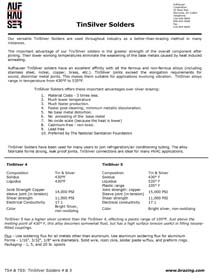Tin-Silver Combination
INTRODUCTION
Our versatile TinSilver solders are used throughout industry as a better-than-brazing method in many instances. The important advantage of our TinSilver solders is the greater strength of the overall component after joining. Their lower working temperatures eliminate the weakening of the base metals caused by heat-induced annealing. Aufhauser TinSilver Solders have an excellent affinity with all the ferrous and non-ferrous alloys (including stainless steel, nickel, copper, brass, etc.). TinSilver joints exceed the elongation requirements for sound, dissimilar metal joints. This makes them suitable for applications involving vibration. TinSilver alloys range in temperature from 430°F to 535°F.
MAJOR ADVANTAGES
- Material Costs - 3 times less
- Much lower temperature
- Much faster production
- Faster post-cleaning; minimum metallic discoloration
- No base metal distortion
- No annealing of the base metal
- No oxide scale (because the heat is lower)
- Cadmium-free - non-toxic
- Lead-free
- Preferred by The National Sanitation Foundation
APPLICATIONS
TinSilver Solders have been used for many years to join refrigeration/air conditioning tubing. The alloy fabricate forms strong, leak proof joints. TinSilver connections are ideal for many HVAC applications.
GENERAL INFORMATION
TinSilver 4 |
TinSilver 5 |
|
|---|---|---|
| Composition | Tin (96%) Silver (4%) |
Tin (95%) Silver (5%) |
| Solidus | 425°F | 430°F |
| Liquidus | 430°F | 535°F |
| Plastic range | 5°F (<1.5%) | 105°F |
| Joint strength (copper sleeve joint) tension | 15,000 psi | 15,000 psi |
| Shear strength | 11,000 psi | 11,000 psi |
| Electrical conductivity | 17.1 | 17.1 |
| Color | Bright silver Non-oxidizing |
Bright silver Non-oxidizing |
STANDARD SIZES AND DIAMETERS
| Diameters (inches) | Package Form |
|---|---|
| 1/16, 3/32, 1/8 | Solid wire, rosin core, solder paste with flux, and preform rings 1, 5, and 20 lbs spools |
ADDITIONAL INFORMATION
TinSilver 5 has a higher silver content than the TinSilver 4, effecting a plastic range of 105°F. Just above the melting point of 430°F, this alloy becomes somewhat fluid, but has a high surface tension useful in filling loosely-fitted couplings. Flux: Use soldering flux for all metals other than aluminum. Use aluminum soldering flux for aluminum. |


